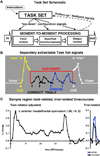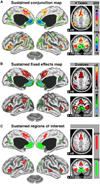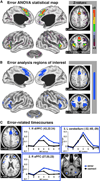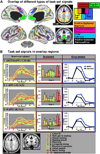A core system for the implementation of task sets
- PMID: 16731517
- PMCID: PMC3621133
- DOI: 10.1016/j.neuron.2006.04.031
A core system for the implementation of task sets
Abstract
When performing tasks, humans are thought to adopt task sets that configure moment-to-moment data processing. Recently developed mixed blocked/event-related designs allow task set-related signals to be extracted in fMRI experiments, including activity related to cues that signal the beginning of a task block, "set-maintenance" activity sustained for the duration of a task block, and event-related signals for different trial types. Data were conjointly analyzed from mixed design experiments using ten different tasks and 183 subjects. Dorsal anterior cingulate cortex/medial superior frontal cortex (dACC/msFC) and bilateral anterior insula/frontal operculum (aI/fO) showed reliable start-cue and sustained activations across all or nearly all tasks. These regions also carried the most reliable error-related signals in a subset of tasks, suggesting that the regions form a "core" task-set system. Prefrontal regions commonly related to task control carried task-set signals in a smaller subset of tasks and lacked convergence across signal types.
Figures








References
-
- Baddeley A. Exploring the central executive. Q J. Exp. Psychol. 1996;49A:5–28.
-
- Badre D, Wagner AD. Selection, integration, and conflict monitoring; assessing the nature and generality of prefrontal cognitive control mechanisms. Neuron. 2004;41:473–487. - PubMed
-
- Barris RW, Schuman HR. Bilateral anterior cingulate gyrus lesions. Neurology. 1953;3:44–52. - PubMed
-
- Botvinick M, Nystrom LE, Fissell K, Carter CS, Cohen JD. Conflict monitoring versus selection-for-action in anterior cingulate cortex. Nature. 1999;402:179–181. - PubMed
-
- Botvinick MM, Cohen JD, Carter CS. Conflict monitoring and anterior cingulate cortex: an update. Trends Cogn. Sci. 2004;8:539–546. - PubMed
Publication types
MeSH terms
Grants and funding
LinkOut - more resources
Full Text Sources
Other Literature Sources
Medical

